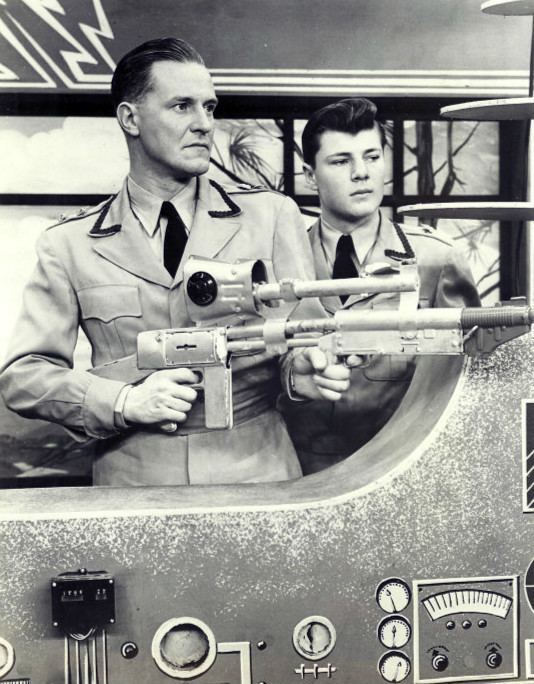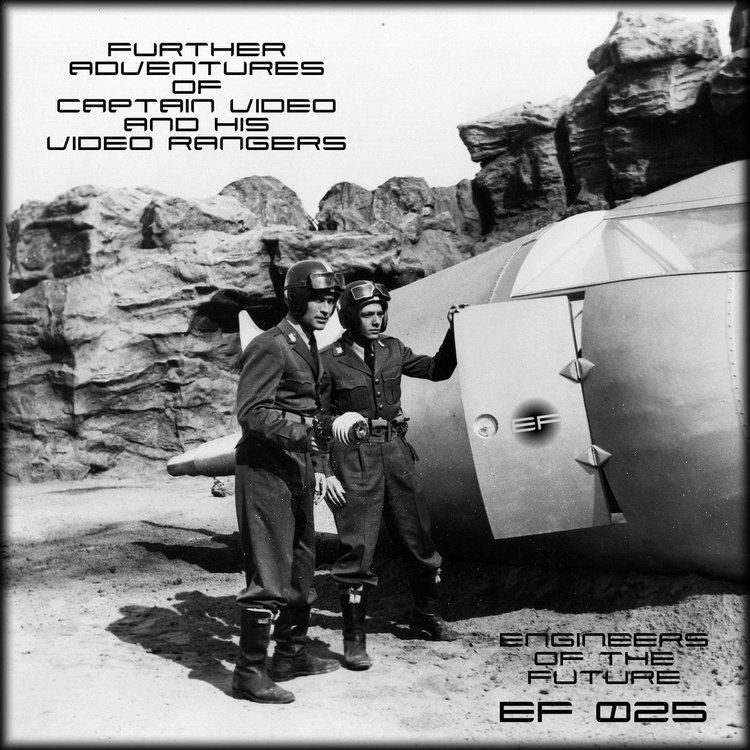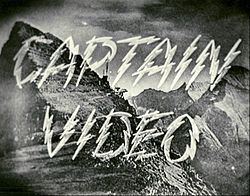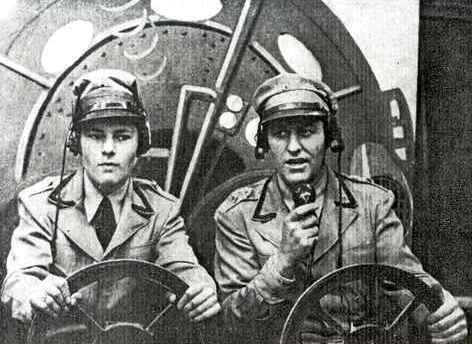7 /10 1 Votes
6.7/10 TV Original language(s) English First episode date 27 June 1949 | 7.5/10 IMDb Country of origin United States Final episode date 1 April 1955 Genre Science Fiction | |||||||||||||||||||||||||||||||||
 | ||||||||||||||||||||||||||||||||||
Created by Lawrence MenkinJames Caddigan Running time 24 mins. (1949-53)15 mins. (1953-55) Cast Similar Space Patrol, Rocky Jones - Space Ra, Captain Z‑Ro, Commando Cody: Sky Marshal o, The Honeymooners | ||||||||||||||||||||||||||||||||||
Captain video and his video rangers tv show 1949 episode
Captain Video and His Video Rangers was an American science fiction television series aired on the DuMont Television Network, and was the first series of its genre on American television.
Contents
- Captain video and his video rangers tv show 1949 episode
- Overview
- Production
- DVD release
- Other media
- Legacy
- References

The series aired between June 27, 1949, and April 1, 1955, originally Monday through Saturday at 7 p.m. ET, and then Monday through Friday at 7 p.m. ET. A separate 30-minute spinoff series called The Secret Files of Captain Video, aired Saturday mornings, alternating with Tom Corbett, Space Cadet, from September 5, 1953, to May 29, 1954, for a total of 20 episodes.

Researcher Alan Morton estimates there was a total of 1,537 episodes (counting the 20 Saturday morning episodes), although only four or five of them exist after the destruction of the original broadcasts, which was commonplace at that time. Sponsors included Post Cereals, Skippy Peanut Butter, DuMont-brand television sets and Power House candy bars. Premiums sold via the show included a flying saucer ring, a "secret seal" ring, cast photos, electronic goggles, a "secret ray gun," a rocket ship key chain, decoders, membership cards, and a set of 12 plastic spacemen.

Overview
The long-run series, set in Earth's distant future, tracked the adventures of a group of fighters for truth and justice, known as The Video Rangers. They were led by Captain Video (no first name ever was mentioned). The Video Rangers operated from a secret base on a mountaintop. Their uniforms resembled U.S. Army surplus with lightning bolts sewn on. Captain Video had a teenage companion known only as The Video Ranger. The Captain received his orders from the Commissioner of Public Safety, whose responsibilities took in the entire solar system as well as human colonies on planets around other stars.
Captain Video was the first adventure hero explicitly designed by DuMont's "idea man" Larry Menkin for early live television. One of its most iconic episodes was titled "I TOBOR." The robot was an important recurring character, and represented the first appearance of a robot in live televised science fiction. Its name was supposed to be "ROBOT I," but the stencil with its name was applied to its costume backward. The robot was played by 7-foot, 6-inch actor Dave Ballard.
Other villains included Doctor Pauli, the "wily Oriental" Hing Foo Sung, and Nargola, played by Ernest Borgnine before he went on to become an iconic stage and film actor. Researcher Don Glut estimated that in all, about 300 different villains appeared on the show at one time or another.
"Captain Video" was broadcast live five to six days a week, and was popular with children and adults. It even earned a special mention in an episode of Jackie Gleason's sitcom "The Honehymooners." Because of the large adult audience, the usual network broadcast time of the daily series was 7 to 7:30 p.m. EST, leading off the "prime evening" time-block. For its last two seasons the show still aired at 7 p.m. ET, but was reduced to a 15-minute segment.
Despite its popularity, throughout its run the production was hampered by a very low budget. Until 1953, Captain Video's live adventures occupied only 20 minutes of each day's 30-minute program time. About 10 minutes into each episode, a Video Ranger "communications officer" showed about seven minutes of old cowboy movies described by the officer, Ranger Rogers, as the adventures of Captain Video's "undercover agents" on Earth.
The reason is that the westerns originally had been purchased by DuMont to be shown in their entirety, hosted by Captain Video, but the format was flip-flopped to become a show about Captain Video occasionally interrupted by clips from the old westerns. Despite the incongruity of mixing the two genres, it was done so the cash-strapped channel would not waste the money spent acquiring the broadcast rights to the westerns.
A spinoff series, "The Secret Files of Captain Video," aired on Saturdays from September 5, 1953, to May 29, 1954, alternating with "Tom Corbett, Space Cadet." Each of the 20 half-hour episodes told a complete story.
Jim Caddigan, DuMont program director, reportedly came up with the series after watching the "Captain Marvel" movie serial, and told his writers to come up with a captain-type character of their own. The stories originally were Earth-bound. mostly taking place in Captain Video's headquarters, due to budgetary restrictions. However, when the "Buck Rogers" TV show was announced by ABC, DuMont moved Captain Video's adventures out into space to compete. Little did they know the "Buck Rogers" show would be cancelled within a few months.
Captain Video's early opponent was Doctor Pauli, played by Hal Conklin (a writer-actor best known for making dozens of short films in the 1920s and '30s). The character was an inventor who wore gangster-style pinstripe suits, snf spoke with the snarl of a movie Nazi or Soviet. Like the last few theatrical serials, the television series' plots often involved inventions created by Captain Video or the evil genius, but obviously made from hardware store odds and ends with much double-talk regarding their fantastic properties.
The series originally was broadcast from a studio in the building occupied by the famous Wanamaker's department store in Philadelphia, and the production crew would simply go downstairs for props, often just a few minutes before air-time. Originally, only three Rangers were seen on camera -- The Video Ranger, Ranger Rogers the communications officer; and Ranger Gallagher. (They also were the only Rangers seen in the 1951 film serial version of the series.) As the budget increased, a larger roster of Rangers was briefly seen on TV. According to Variety, the female lead was played by Norma Lee Clark.
Captain Video eventually had the use of three different spaceships. In the first ship, the X-9 (later replaced briefly by the X-10), the crew at takeoff lay upon tilted bunk beds on their elbows, a posture based upon space-travel theories of the time. Later, the V-2 rocket-like ship named "Galaxy" had an aircraft-style cockpit with reclining seats. The Captain's final spacecraft, after early 1953, was the "Galaxy II."
The other space adventure series of the period were "Tom Corbett, Space Cadet,' (DuMont), also broadcast live from New York City, and "Space Patrol (ABC), broadcast live from Los Angeles. There were some plot similarities among the three. At times, for example, "Space Patrol" seemed to be doing a West Coast recreation of Captain Video's latest adventure.
Al Hodge, who had portrayed the role of Britt Reid, "The Green Hornet" on radio, is the Captain Video most original viewers of the series remember (1950–1955). However, the original Captain Video was Richard Coogan, who played the role for 17 months. Conversely, The Video Ranger was played during the entire run by teen-aged Don Hastings, who later became a longtime soap opera star.
During commercial breaks, DuMont aired special "Video Ranger messages". They ranged from public service spots on morality and civics to advertisements for Video Ranger merchandise. Many premiums were offered by sponsors of the show, including space helmets -- which received a boost when actor Art Carney's Ed Norton character wore one on an episode of "The Honeymooners," secret code guns, flying saucer rings, decoder badges, photo-printing rings, and Viking rockets complete with launchers. A clip of in-show advertising can be seen on YouTube.
Production
Even for its time, when early television productions often were thrown-together affairs, the quality of the show often is considered crude or low-budget, owing much to the fact that the show was done live and DuMont had a meager budget to work with. A laudatory review by comic author Dave Barry referenced the "Captain Video Rocket Ring," a promotional tie-in piece of merchandise distributed via Power House candy bars, saying that the ring "seemed to have a higher production value than the actual TV show."
In the early days of the series, the show featured often incoherent scripts, along with jarring plot shifts to old cowboy movies. This led to derision of the show by the critics of the day, although it always was wildly popular with kids and many adult. This improved after 1952 when scripts began being written by such major science fiction writers active at the time as Damon Knight, James Blish, Jack Vance and Arthur C. Clarke. These late scripts displayed more intelligence, discipline and imagination than most of the other children's sci-fi series scripts of the era. Other well-known authors who occasionally wrote for the program included Isaac Asimov, Cyril M. Kornbluth, Milt Lesser, Walter M. Miller, Jr., Robert Sheckley, J. T. McIntosh and Robert S. Richardson. One of the more prolific writers for the show was Maurice C. Brachhausen -- who wrote under the name M.C. Brock, and later had his own production company, Brock Video Productions.
Throughout the run of the series, it had a meager budget despite its success with the general public. in fact, according to most records, T=the show's "prop budget" was a miserly $25 per week.
Few special effects were evident until the team of Russell and Haberstroh was hired in September 1952. For the rest of the program's episodes, they provided effective model and effects work, prefilmed in 16 mm format and cut into the live broadcast as needed.
The show's theme song was Richard Wagner's "Overture to The Flying Dutchman". Captain Video's "mountaintop headquarters" was a drawing on a 4 X 4' piece of cardboard on an easel. The "Opticon Scillometer" gadget was made out of a car muffler, a mirror, a spark plug and an ashtray. The interior of Captain Video's spaceship, the Galaxy, was made entirely of cardboard with the instruments and dials painted onto the cardboard.
The actors were paid so little they actually made more money from appearing in character at supermarket openings, county fairs and the like than they did from their salaries. The original star Richard Coogan left the show in 1950 partially because the show's producers refused to cut in the cast members for a percentage of the licensing dollars from the sale of Captain Video merchandise. Bram Nossen, who played Dr. Pauli, dropped out in 195, after suffering a nervous breakdown from having to appear on TV six days a week, was replaced by Hal Conklin, and in 1954 Stephen Elliott assumed the role. The jarring change in actors who looked nothing like each other was explained by saying that the villainous Dr. Pauli had undergone plastic surgery to outwit Captain Video.
The series is mentioned in the first of the 39 independent episodes of The Honeymooners, "TV or Not TV." As noted, "Honeymooners" character Ed Norton was a fan of the show. Prominent U.S. Senator and presidential candidate Adlai Stevenson once delayed a scheduled TV announcement until after Captain Video had aired because he feared everyone would be watching that show.
The series is also prominently mentioned in Barbara Kingsolver's novel The Lacuna (2009). After the protagonist, author Harrison William Shepherd, is persecuted by the House Un-American Activities Committee, his stenographer and friend Violet Brown observes, "After the hearing he'd stopped writing, for good he said. Instead he bought a television set and let its nonsense rule his days. Mook the Moon Man comes on at four, and so on." She adds, "He was so changed by then, even his looks. Whatever used to show up for its workaday there inside him, it had shut off the lights and gone on home. He was fagged out in the chair as usual, in his old gray flannels, smoking, never taking his eyes off the set. 'Captain Video' was on, some underwater band of thieves fighting. They had Al Hodge by the neck, fixing to drown him." The scene Violet describes portends later developments in the novel.
DVD release
Four episodes of Captain Video and His Video Rangers were released on Region 0 DVD by Alpha Video on November 25, 2008. It is thought that these are the last 4 remaining episodes in existence, except for 24 episodes owned by the UCLA Film and Television Archive, only viewable as part of a showing within the archive building. Some of these prints also contain an episode of Marge and Jeff, a weekday sitcom which aired after Captain Video during the 1953-1954 TV season.
Other media
Columbia Pictures made a movie serial, starring Judd Holdren, under the name Captain Video: Master of the Stratosphere (1951). However, it displayed only marginally better sets and props than its TV inspiration. Some special effects were accomplished with cel animation, inspired by earlier use in another, successful serial from the same studio, Superman (1948). Columbia's movie serial was the only time a serial was based on a television program. Tom Corbett and Space Patrol were also heard on the ABC Radio Network. However, since DuMont had no affiliated radio network, DuMont never provided a radio version of Captain Video's adventures.
Six issues of a "Captain Video" comic book were published by Fawcett Comics in 1951. The rival space adventure programs Tom Corbett and Space Patrol shortly thereafter had their own comic books as well. Some of these comics were used as the basis for a British TV Annual, a hardcover collection produced in time for Christmas, which also made the claim that man would venture into space in 1970 and would reach the moon by 2000.
Legacy
Captain Video comes close to being a lost series. Only five 30-minute episodes, three featuring Richard Coogan and two featuring Al Hodge, have been available to the public on home video.
DuMont's film archive, consisting of kinescope (16 mm) and Electronicam (35 mm), was destroyed in the 1970s by Metromedia, the broadcast conglomerate that was the successor company to DuMont, thus dooming nearly all of its pioneering TV series to oblivion. To date, the person or persons responsible for ordering the destruction of the kinescopes and other recordings remains unknown.
As a result of there being so few surviving episodes, it is not clear what time period the series is set in. The Fawcett comic adventures are supposed to take place during the time of publication, in 1951. However, the stories in the surviving kinescopes could take place in 1950, as when Dr. Pauli plots to rob a bank in Shanghai, or centuries into the future, as when Captain Video seeks to establish a reliable mail service for far-flung interstellar (or at least interplanetary) colonies (depicted in a surviving episode generally called "Chauncey Everett") or struggles to prevent the many space stations circling Pluto from being destroyed by an approaching comet. Later episodes' television listings would seem to indicate that Captain Video and other characters on the show were indeed capable of routine interstellar travel.
